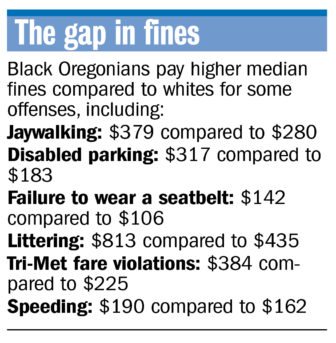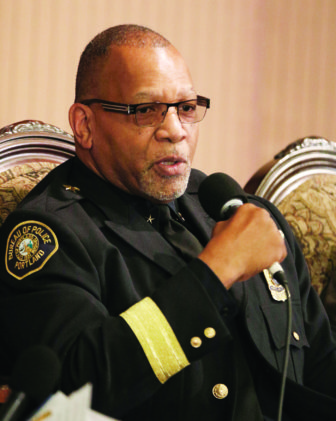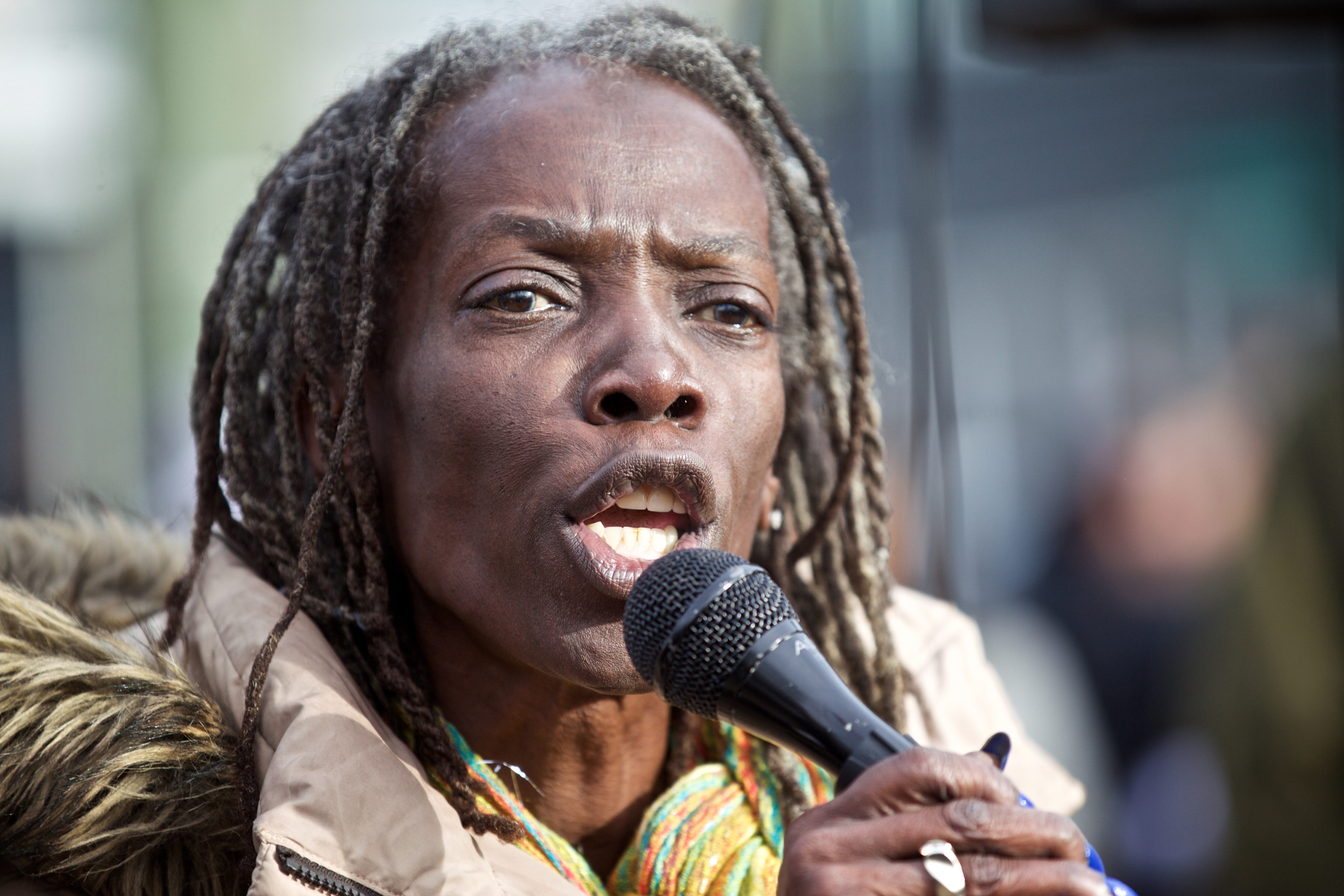For everything from jaywalking to driving without a license, it pays to be white in Oregon if you run afoul of the law.
What you really don’t want to be is black.
For example, littering fines for African-Americans are nearly double those imposed on whites, according to an analysis of cases filed in state courts from 2005 to 2016. Transit fare violations? Those fines, too, are more than doubled if you’re black.
Our review of the past dozen years of court records shows that white residents charged in relatively minor cases in Multnomah County — those with a single count — paid a median fine of $181, while African-American defendants paid $261.
Since 2005, that disparity added up to about $5.6 million.
If you look at fines related to all cases, African-American defendants in Multnomah County paid about $21.5 million more than they would have if their fines had been equal to those levied on white defendants.
“These are the hidden injustices built into the justice system,” said Jo Ann Hardesty, president of the Portland Branch of the NAACP and a former state legislator.
Living black in Multnomah
When people discuss racial disparities in the criminal justice system, they often focus on cops. Yet, as evidenced by the gap in fines (which are outside the control of police), obstacles to obtaining equal justice in Multnomah County — and throughout Oregon — are seen at every tier of the criminal justice system.
Prosecutors, the courts and even state legislators play a role in perpetuating the disparities, but it’s logical to zero in on police, who make the first — and very public — contact with people who end up in our courts and jails.
In Multnomah County, ticket by ticket, arrest by arrest, African-Americans are charged three to 30 times as often as white residents for everything from pedestrian and transit fare violations to drug charges and crimes related to interactions with police.
For black people in Multnomah County, unequal treatment in the criminal justice system is nothing new.
Lauretta Reye Austin, 22, described being hassled by a cop while waiting at a MAX station.
Teressa Raiford, 46, and a leader of Don’t Shoot PDX, said it was only after talking to white girls that she learned police didn’t know all young kids by name — just the black kids.

Teressa Raiford went from being a pro-cop anti-gang activist to leading the group Don’t Shoot PDX. She says she learned from an early age that her skin color merited special attention from police.
Red Hamilton, 40, a Milwaukie resident whose family lives in North Portland, says her brother has been stopped by police while walking to work.
“They ask him stuff like, ‘Oh, where you going? You look familiar,’” Hamilton said, “criminalizing him by just his skin tone.”
And then there’s Kevin Jones’ story from last July.
The co-founder of an arts group, Jones was parked in the loading dock outside the Artists Repertory Theatre in downtown Portland, talking with his production assistant, when an officer activated his squad car lights and began questioning him — the officer’s hand either on his gun or resting very near it, his partner standing further back.
Jones, who was then directing a play on racial profiling for the August Wilson Red Door Project, asked what the basis for the stop was, pointing out that he was parked legally and rented space at the theater.
Eventually, the police were persuaded and drove away. But the officer’s initial response to his questioning struck Jones as out of line. “If you’re going to have an attitude, let me have your driver’s license,” he recalled the cop saying.
Such tales are the reality of life inside these numbers: Of the 202 types of offenses for which there was adequate data to compare — everything from mail theft to murder to escape from prison or custody — African-American residents in Multnomah County were charged at higher rates than whites for all but five types of crimes. And in 80 percent of those crimes, they were charged at two or more times the rate of whites.
Stark gap for drug crimes
The biggest disparities are seen in drug crimes. Researchers have found that African-Americans use most drugs, including powder cocaine, at lower rates than whites. The only drug black people consume at a higher rate is crack cocaine.
Yet black residents in Multnomah County were charged at a rate seven times that of whites for all drug cases. In minor cocaine cases, mostly single counts of possession, the rate was 30 times that of whites.
African-American residents were more likely to be charged with crimes related to their exchanges with police, too. They comprise just 7 percent of Multnomah County’s population, including people of mixed race, but make up nearly a third of charges for interfering with a police officer and giving false information to police, and more than a quarter of cases for resisting arrest.
Those findings are hardly shocking. A year ago, the county released a study, funded by the MacArthur Foundation, that found African-American defendants were six times as likely as whites to end up in the county jail.
Police want to get ‘into pockets’
What is surprising is the unexpected, little-discussed daily experiences of black residents who are more likely to be slapped with violations for things that white people rarely even think of as violations.
Spitting in public? Black people were charged at 27 times the rate of white residents. Failing to cross the street at a right angle? Fifteen times the rate of whites.
Jaywalking? Eight and a half times the rate of whites. Walking in the road? Five and a half times the rate of whites. Littering? Nearly four times the rate of whites.
Time and again, African-American residents interviewed for this series characterized Multnomah County as a place where police use petty violations as an excuse to get their names and “get in their pockets” to look for contraband.
“In a busy city, living a busy life, these are the little crimes that we do,” Hardesty said, referring to people of all races. She worries that the disproportionate enforcement may be “a practice and pattern of targeting people because you just have to charge someone with something — right? Because you just need to get them in your database.”
Varies by ZIP code
Records and interviews point to a variety of factors contributing to why the system works the way it does.
The Portland Police Bureau is one of the few agencies in the state to track the race and ethnicity of people stopped by its officers. The most recent “stop data” report suggests that while police are stopping fewer people than in the past, African-Americans are still stopped at twice the rate of whites by the city’s patrol and gang enforcement officers.
Where you live makes a difference. Police in Portland, much like those in other cities, are deployed to neighborhoods based on the number of police calls — the more calls there are in an area, the more cops you’ll see.
Police call it “differential exposure,” meaning the more exposed to police you are, the more likely you are to have police contact. So a white youth and a black youth engaged in similar criminal activity can have different arrest records simply by virtue of their ZIP codes.
African-Americans in Portland are concentrated in neighborhoods that tend to have lots of police answering lots of calls and using tactics such as “pretext stops” and “mere conversation” to engage with potential criminals.
“Over half of all citizen-initiated calls for police service, violent crime and traffic stops come from one-quarter of Portland’s 94 neighborhoods,” according to a 2009 study conducted for the police bureau. “Thus, it is safe to assume that police presence and proactive policing tactics are intensified in these 24 neighborhoods.”
More than half of the city’s African-American population resides in these 24 neighborhoods, the report found, “and two-thirds of African-American traffic stops occur in these neighborhoods.”
In recent years, gentrification has pushed African-Americans into the eastern part of the county and elsewhere. But in their new neighborhoods, criminal activity, such as street-level drug dealing, is still far more subject to 911 calls than, say, in the West Hills. In the West Hills, prescription drug abuse and other crimes associated with upper-income residents are seldom reported to the few officers patrolling there, said one African-American officer, who spoke on condition of anonymity.
But it’s not all about geography, says Kasia Rutledge, a public defender and defense attorney.
She said police tend to target people who might be carrying a weapon (black residents are charged at a rate 17 times that of whites), drugs or have outstanding warrants. People of color are assumed to be more likely than whites to engage in those activities, she said.
And once they’re known to police, she said, they’re stopped repeatedly. “It’s just a longstanding fish-in-the-barrel kind of thing,” she said.
Not showing up in court
So why do African-Americans caught breaking the law pay higher fines for everything from harassment to failing to wear a seatbelt?
Default judgments may be a factor. The $21.5 million in higher fines over the past decade reflects all cases, from serious crimes to minor violations. About a quarter of them, however, were issued in single-charge cases, often traffic violations. Nan Waller, presiding judge at the Multnomah County Circuit Court, said that may suggest the fines were issued to people who, for whatever reason, simply did not make it to the court for a hearing.
“Did this come about as a result of the judge ordering the fine or as a result of a default?” she asked. “What we’re interested in is, why did it happen?”
Fine line for police
Community members interviewed said there’s a fine line between crime prevention and outright bias.
In 2015, 18 percent of violent crime victims were black, according to police reports, so African-Americans are more than twice as likely as white residents to be victims of crime.
Police say they find themselves wedged between communities that expect them to respond to violence and a desire to restrain from profiling people of color and overpolicing the black community.
And there’s what Portland Police Capt. Kevin Modica, who is African-American, calls the intangible “otherness” of being black in the whitest big city in the United States. How many additional police calls about African-Americans are due to the bias of the people dialing 911?
Kevin Jones and the cast of “Hands Up,” his theater group’s long-running production about racial profiling, recently attended a Citizens Police Academy training put on by the Portland Police Bureau for members of the community.
Jones said his group — predominantly African-American males with their own experiences of being stopped — walked away from the police academy in general agreement that the “problem of police profiling goes way beyond this notion of police harassment.”
“There are plenty of systems in place that cause the problems” facing African-Americans when it comes to justice disparities, Jones said. But rather than waiting for others to address the problems, “I would love to see attention put on the development of the African-American community in terms of education, in terms of mental health, in terms of employment. … As a community of people, I think we have work to do as African-Americans in cleaning up our own backyard, focusing on our own systemic problems, and coming to the realization that if we’re going to get out of this mess we’re going to have to (focus on) that kind of work.”
Gang violence and disparity
In recent years, when literally thousands of bullets were fired within city limits, a disparate number flew in shootings involving African-American gangs, says Portland Police Capt. Mike Krantz.
That likely fuels disparate rates of police stops and searches, he says. “So much of it depends on environmental factors that are way out of the police bureau’s control.”
One former high-level Portland police official, speaking confidentially in an interview last year, provided a more succinct version of this argument: “Portland has a black gang problem.”
Constantin Severe, director of the city’s Independent Police Review office, has a close-up view of the tensions between police and Portland’s African-American community, of which he is a member.
About 20 percent of the complaints filed against police with his office are from African-American residents, often questioning why someone was stopped. But African-Americans made up at least a third of the homicide victims in Portland last year, many from gang shootings.
“I want the government to address that,” Severe said. “At the same time, I don’t want the government to be stopping my son on his way to work or when he’s minding his own business.”

Portland Police Captain Kevin Modica talks during a panel discussion on race and police policy at the
City Club.
Meanwhile, police intervention falls near the end of what Capt. Modica describes as “a cascading tumble” of failing systems for people of color: Poverty. A school system more likely to fail black children. Families more often lacking support.
Police have deployed officers in schools and neighborhoods as a means of curbing violence and partnered with county agencies to intervene early. But those tactics have led to push-back from some people in the black community.
Raiford said it feels less like help than tracking. A system where strangers learn their names, learn who their family is, and then send them to jail anyway.
Addressing disparities
CJ Robbins, the city’s Black Male Achievement Program coordinator, deals with minority youth on a daily basis. “Oftentimes, police and (prosecutors) feel justified in saying, ‘These are bad guys on a bad path,’” he said.
But being placed on the police bureau’s list of suspected gang affiliates, or otherwise labeled, has a lingering, stigmatizing effect that diminishes the effectiveness of public health and social service programs.
Critics of the Portland Police Bureau, including some defense attorneys and judges, question the gang enforcement unit’s almost-exclusive focus on black people, especially while police concede white gangs can be some of the most brutal and terrifying around — known for drug trafficking, home invasion robberies, and even torture.
“Guess what race most of my clients who are gang members are?” said Rutledge, the public defender. “They’re white.”
This focus on black gangs filters into other areas, such as prostitution — where cops say gangs now more frequently engage in human trafficking than the drug trade, because it is easier to avoid being convicted. That could be partly why, despite accounting for only about 7 percent of the county population, black residents were associated with 86 percent of sex trafficking charges, 80 percent of promoting prostitution charges, and 70 percent of drug-free zone violations.
Modica and Portland Police Chief Mike Marshman say these disparities can be addressed with better training, improved communication with community members, and increased use of programs that divert first-time offenders from the criminal justice system into programs or other alternatives to sentencing.
A 2014 settlement agreement boosted monitoring and oversight of the bureau after a federal investigation concluded Portland police engaged in a pattern of excessive force.
And Portland police will participate in a new program intended to divert addicts, the homeless and the mentally ill from local jails, called the Law Enforcement-Assisted Division program, which is starting up this month.
Marshman and Modica say that in the past two years, reacting to civil rights lawsuits alleging discrimination, the bureau has started training officers differently to make sure they have a legally defensible reason to engage with someone and search them.
They say that efforts launched decades ago to fighting drug abuse resulted in the aggressive “in our pockets” tactics that have drawn community complaints and made racial disparities worse.
The message to officers now is “Don’t try to fool people” into giving consent to a search, Modica said.
Marshman, a 25-year veteran of the bureau who was sworn in as chief last summer, said police also need engage with other agencies to address basic inequities contributing to African-Americans’ over-representation in arrest numbers:
“What can the police do to bring other entities that we usually don’t partner with — schools, health care system, housing — to the table to lessen that?”
Next week: What role do prosecutors and judges play in criminal justice disparities?




Another great article by Lee van der Voo. Lee is a master for mining data and honest reporting. I am pleased to see collaboration with Nick Burdick, Portland Tribune and Pamplin Media Group. InvestigateWest is giving us a sign that journalism has shifted from a sole newsroom model, the Boston Globe investigating a story as in “Spotlight,” to a collaborative model as in the Panama Papers. And, in my opinion, this change is happening just in time.
Nice job Nick and Lee. An excellent story.
Excellent, informative and sobering journalism. These aren’t “alternative facts,” they are the truth about intentional, historical – and current – system bias fueled by 0practices of racism in Portland’s Multnomah County. The questions have been raised and confirmed, the African American community has long known what unjust and “just us” means. My question, what is Portland and Multnomah County law enforcement and justice institutions going to do different- beyond talk – to move beyond these entrenched patterns?